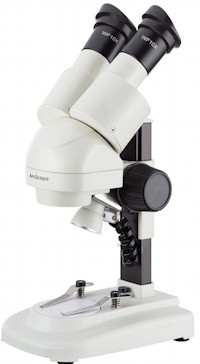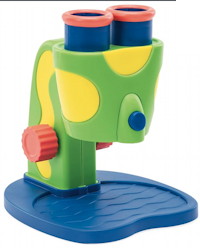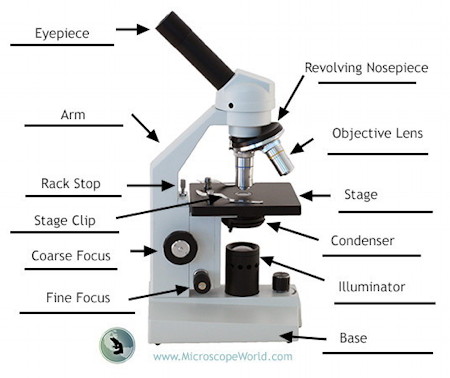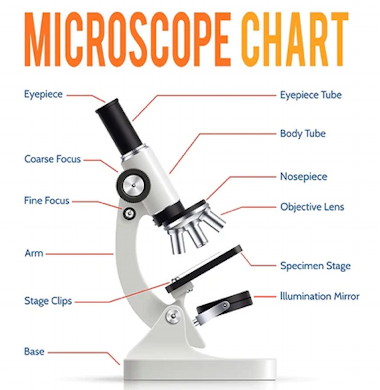last updated 12 Nov 2023
Contents: Microscopes overview | Recommended Stereo Microscopes
See also Glossary on the microscopes page.
Microscopes are one of the most widely used tools in science.
They mignify things from 5 times (5X) to 1,500 times (1,500X)
Analog microscopes that use light and mirrors to magnify objects usually max out at about 1,500x magnification. This is because light wavelengths cause the image to appear unclear at that magnitude of magnification.
Electron microscopes, however, can produce images that exhibit impressive clarity all the way up to 200,000x magnification since electrons have much shorter wavelengths.
Overview:
When I googled kids microscopes I got 30+ between $50 and $120
More than half were 200-1200 power which are not recommended for younger kids.
Best-microscope-for-kids | microscope.com says
When you are looking for the best childrenŐs microscope, you should look for one that is durable and simple to use. DonŐt be fooled into thinking you need extremely high power magnification for a kids microscope. The most interesting specimens for kids to look at, bacteria and their own cheek cells only require 40x-400x. The best microscopes often include additional accessories such as carrying/storage cases and prepared slides so that viewing can begin right away. Most importantly, any microscope chosen for a kid should encourage scientific exploration in a fun and educational way.
The younger the child, the lower the magnification power should be because powerful optics can be more difficult to operate.
Microscopes with a 5X to 400X magnification power will be great for younger kids.
Most of the microscopes listed for kids wre Compound microscopes with a single eyepiece and the objective lens (at the bottom close to the specimen stage which is typically a slice on a slide (small rectangular piece of glass).
Compound microscopes have much higher optical resolution with magnification ranging from about 40x to 1,000x.
For school age kids The most interesting specimens for kids to look at, such as bugs, bacteria and their own cheek cells only require 40x-400x.
They are able to magnify objects up to about a thousand times. Since most cells are between 1 and 100 µm in diameter, they can be observed by light microscopy, as can some of the larger subcellular organelles, such as nuclei.
See size
Stereo microscopes (also called dissecting microscopes) have lower optical resolution power where the magnification typically ranges between 6x and 50x. There is a larger space between the objective lense and specimen stage, so they can accommodate larger objects, insects, plants, rocks, ...
They can also be used for dissection (Cutting up small animals).
Most younger kids < 8 years old are more interested in viewing these things than cross sections of neurons.
My opinion: Stereo microscopes are good for kids for 2 reasons.
- 2 eyepieces so you don't have to squint thru 1 eye.
- Accommodates large objects, insects, plants, rocks, stamps, jewelry, stamps, coins, fabrics, fingerprints, electronic circuit boards, etc. 20x has limited field of view.
Good for dissection.
- 3D image
An angled head is good because they can use it sitting down.
A 10x magnification is good because
Recommended Stereo Microscopes
I got the IQCrew By AmScope SE120 Series Outlet Kid's Portable Stereo Microscope 20X Magnification with Angled Head
for $38
 It is manufactured by IQCREW but labeled as AmScope which distributes it via Amazon
It is manufactured by IQCREW but labeled as AmScope which distributes it via Amazon
>
It comes with a 2x objective lens (The end at the bottom) and a 10x eyepiece for a magnification of 20x.
This gives a small field of view of 0.9 (mm) which is too narrow from many bugs.
So I ordered a 5x eyepiece to give it 10x magnification with a 1.8 mm or 0.7 inch field of view.
You can also get up to a 25x eyepiece for 50x power
and a digital eyepiece to display on a computer.
Ages: 13 and younger. Several comments said their 4 year olds had no problem with it.
- Elementary stereo microscope for home or classroom use enables students and hobbyists to inspect
biological specimens, rocks, stamps, jewelry, and large specimens that require handing or manipulation
- Binocular viewing head with interchangeable pairs of 5x and 10x widefield eyepieces, adjustable interpupillary distance, and fixed vertical inclination to simplify viewing for young users
- 2x objective provides low magnification and longer focal length for inspecting large-scale specimens
- Reflected upper illumination has battery-powered 1W LED light source to illuminate specimens from above
- Reversible black and white stage plate provides contrast with light- and dark-colored specimens, and stage clips secure the specimen
AmScope SE120 Portable Binocular Stereo Microscope, WF10x Eyepieces, 20X Magnification, 2X Objective, LED Lighting | Amazon,
IQCrew 10X & 20X Portable Stereo Microscope $56
Reviews:
10-20x model
-
4.1 61% 5star
5-star - My 4-year old finds it easy and intuitive to use. Maybe straight oculars is better for him than inclined ones, the company also make a model with 45degrees tilted oculars.
4 star - you may have a period of adjustment while learning to use the product.
4 star - My 5 year old grandson (scientifically advanced for his age) loved it.
One problem, the white base insert doesn't stay in when it is put back in the styrofoam box insert. It would be nice if it snapped in more securely.
Another problem with the one I got is that one of the eyepieces doesn't fit down in the hole all the way. It stays up about 1/8 of an inch. While it might affect a grownup's viewing, I doubt a child will notice at all.
20x model
4.1
- 5 star - They are not terribly sturdy.
As a lightweight, easy to use scope that we can lug through the greenhouse to check for insect pests, they fit the bill perfectly.
- 5 star - only downside is the single LED light, so I took the LED light off and got a fluorescent ring light and mounted it so now itŐs great
- For a $45 microscope it's great! The bad reviews were from people who's scopes arrived broken which makes sense.
- 4 star- No individual eyepiece adjustment.
With the 10X eyepieces the actual field of view is just under 10mm in diameter so you are not going to see all of a coin or stamp in the field of view. Only a zoom binocular microscope that can go to 7X or less will have the needed very wide field of view for such use.
The IQCrew 10X & 20X Portable Stereo Microscope $56
- 4 star- Eye pieces are not fixed and tend to flex (eyepieces move apart) if you have a habit of resting your head on them.
- The elevation mechanism doesnt grip well so frequently when turning the height knobs, the lens doesnt move at all and you have to fiddle with it (mine could be defective)
-single LED for illumination? They could have put in a few more. As a result the lighting is a bit uneven and harsh.
- 3 star - There is nothing other than gravity securing the eyepieces in to the frame, so you have to be careful. Was a problem with preschoolers.
- 1 star - Batteries shorted out. Focus knob on both units runs off the end and will not come back up without grabbing the eyepiece holder and forcing it back to engage.
one of the fixed lens on the main body had an imperfection like some goo or link was in the head piece. optics were just fine
- Arrived inoperable. Returned.
Also listed at
AmScope Outlet IQCrew 20X Kid's Portable Stereo Microscope |amscope
 Educational Insights GeoSafari® Jr. My First Microscope
Educational Insights GeoSafari® Jr. My First Microscope
8x magnification for a larger field of view that the 10x above.
Ages 3+
Designed by a scientist and mother of two preschoolers, My First Microscope allows kids to see a magnified hidden world with ease! This fully functional microscope is a real working science tool with two extra-large eyepieces and a chunky, kid-sized focusing knob. A bright LED with easy push-button action lights up details for even more discoveries.
Reviews 4.2
57% 5 star
3-4 star reviews
A Several arrived broken and others broke after a little use.
Magnification not impressive.
Specimens:
You can get sets of specimens for kids to view:
For Stereo microscopes:
Bugs at Etsy
Bugs in epoxy at LakeshoreLearning
Mineral Rocks | AmScope
Fossil Starter Set, 4 specimens
For compound microscopes:
48pc Color-coded Prepared Plastic Microscope Slides with Plant, Insect, Mammal, Bird and Fish Specimens
Glossary:
Stereo Microscope
>
Also known as dissection or dissecting microscopes, stereo microscopes have dedicated objective lenses and eyepieces for each eye. The separate optical paths create two axes offset from one another, providing depth perception for a three-dimensional view. This makes stereo scopes ideal for viewing dissection or any larger objects that you may need to manipulate as you observe.
Here are some that were recommended.
Compound microscopes
have much higher optical resolutions, so theyŐre best for viewing or inspecting small specimens requiring very high magnification, including bacteria, plant cells, algae, protozoa, animal cells, chromosomes, and thin slices of organs or tissues. They have a small working distance, which varies from 0.14 to 4 millimeters and is ideal for ultra-thin samples that you can pass light through.
Microscope Anatomy:


Purchase Warning:
MicroscopeWorld.com has a stereo 20 power microscope on sale for $125 that looks identical to the AmScope SE120 Portable Binocular Stereo Microscope for $39 at amazon.
Links:
Best-microscope-for-kids | microscope.com
Best microscopes for kids | Popular Science
Buyers Guide to Microscopes for Elementary Schools: What Microscope Should I Buy? | AmScope
 It is manufactured by IQCREW but labeled as AmScope which distributes it via Amazon
It is manufactured by IQCREW but labeled as AmScope which distributes it via Amazon Educational Insights GeoSafari® Jr. My First Microscope
Educational Insights GeoSafari® Jr. My First Microscope